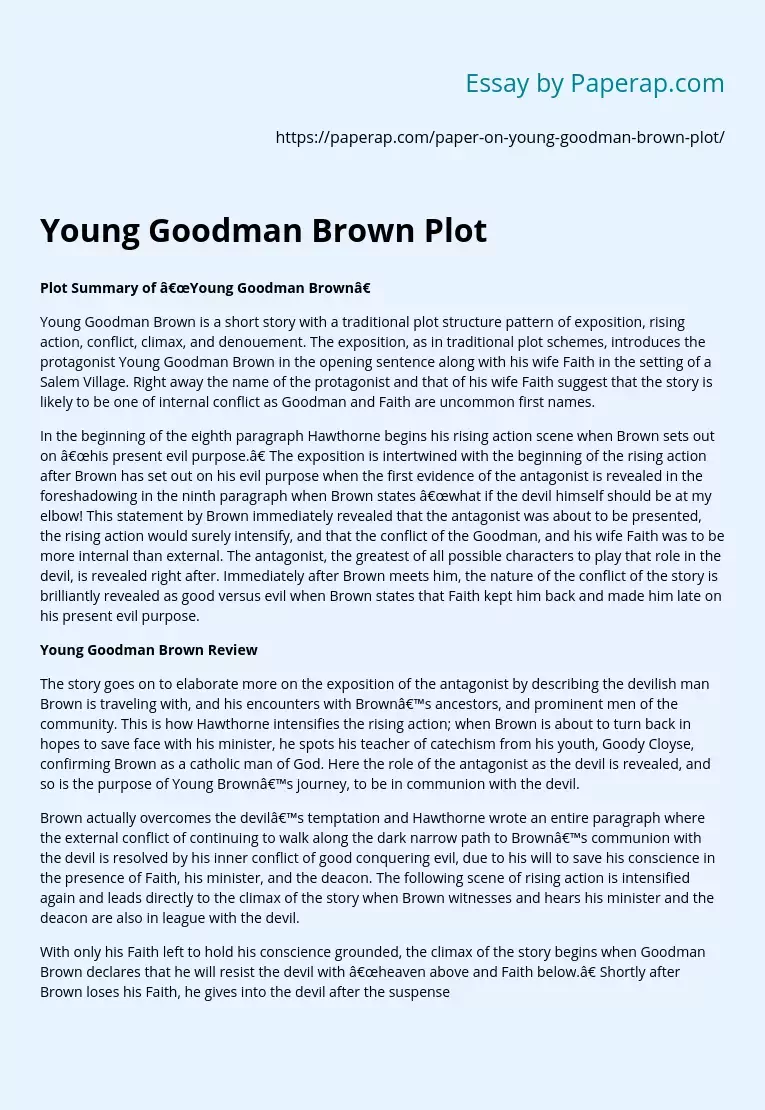Young Goodman Brown Plot
Plot Summary of “Young Goodman Brown”
Young Goodman Brown is a short story with a traditional plot structure pattern of exposition, rising action, conflict, climax, and denouement. The exposition, as in traditional plot schemes, introduces the protagonist Young Goodman Brown in the opening sentence along with his wife Faith in the setting of a Salem Village. Right away the name of the protagonist and that of his wife Faith suggest that the story is likely to be one of internal conflict as Goodman and Faith are uncommon first names.
In the beginning of the eighth paragraph Hawthorne begins his rising action scene when Brown sets out on “his present evil purpose.
” The exposition is intertwined with the beginning of the rising action after Brown has set out on his evil purpose when the first evidence of the antagonist is revealed in the foreshadowing in the ninth paragraph when Brown states “what if the devil himself should be at my elbow! This statement by Brown immediately revealed that the antagonist was about to be presented, the rising action would surely intensify, and that the conflict of the Goodman, and his wife Faith was to be more internal than external.
The antagonist, the greatest of all possible characters to play that role in the devil, is revealed right after. Immediately after Brown meets him, the nature of the conflict of the story is brilliantly revealed as good versus evil when Brown states that Faith kept him back and made him late on his present evil purpose.
Young Goodman Brown Review
The story goes on to elaborate more on the exposition of the antagonist by describing the devilish man Brown is traveling with, and his encounters with Brown’s ancestors, and prominent men of the community. This is how Hawthorne intensifies the rising action; when Brown is about to turn back in hopes to save face with his minister, he spots his teacher of catechism from his youth, Goody Cloyse, confirming Brown as a catholic man of God. Here the role of the antagonist as the devil is revealed, and so is the purpose of Young Brown’s journey, to be in communion with the devil.
Brown actually overcomes the devil’s temptation and Hawthorne wrote an entire paragraph where the external conflict of continuing to walk along the dark narrow path to Brown’s communion with the devil is resolved by his inner conflict of good conquering evil, due to his will to save his conscience in the presence of Faith, his minister, and the deacon. The following scene of rising action is intensified again and leads directly to the climax of the story when Brown witnesses and hears his minister and the deacon are also in league with the devil.
With only his Faith left to hold his conscience grounded, the climax of the story begins when Goodman Brown declares that he will resist the devil with “heaven above and Faith below.” Shortly after Brown loses his Faith, he gives into the devil after the suspense of the heaven’s blotting out by the dark cloud, and the Haunting voices of the forest are followed by the screams of a woman and the pink ribbon of his Faith falls from the cloud. The denouement of the story is Brown giving into the devil by losing his Faith, and the resolution of the internal conflict of good versus evil is Brown turning to evil.
After the denouement the falling scenes are that of Brown flying through the forest to his communion with the devil. All the scenes following the climax are that of the falling action, although there is almost a second climax when Brown has some hope and tells Faith to “look up to the heavens, and resist.” This last conflict is resolved by Brown waking up from his dream, losing his internal conflict and as a result Brown losses his Faith and evil wins in his heart until the day he goes to his grave.
Young Goodman Brown Plot. (2019, Dec 05). Retrieved from https://paperap.com/paper-on-young-goodman-brown-plot/

